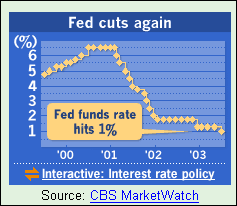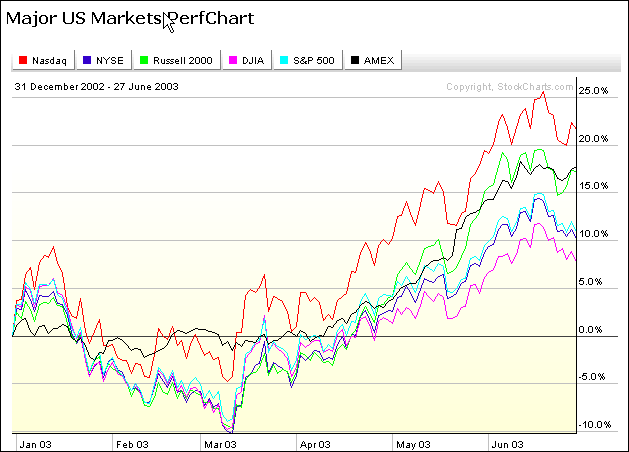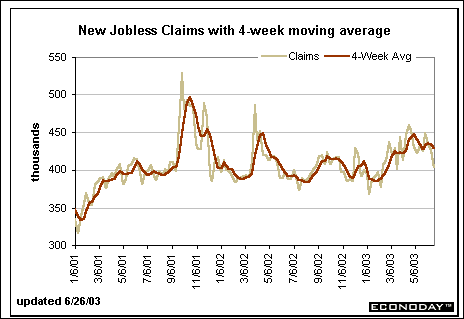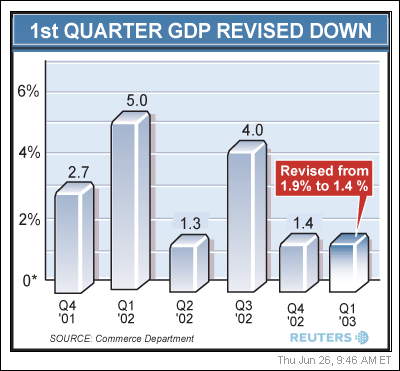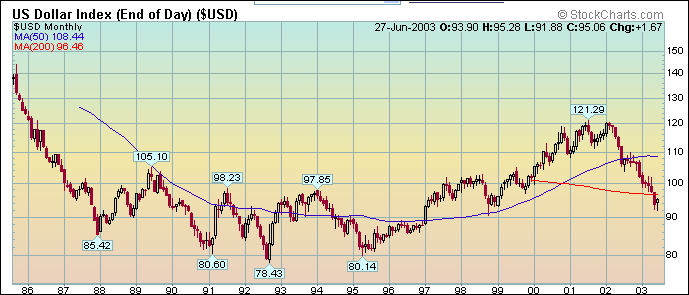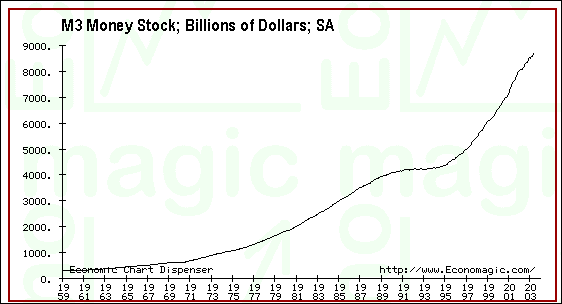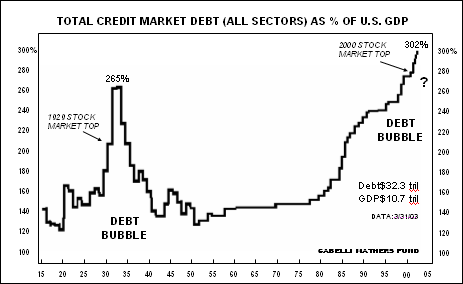Will the second half be any better? |
|
The best that can be said for the first half is that most statistics failed to turn substantially negative while a few showed improvement. Rather, the economy continued to muddle through the pitfalls caused by the Federal Reserve, politicians increasing spending and deficits, and the aftermath of both the Iraq adventure and the constantly changing geo-political wars. During the past six months, we have seen the impact of the Iraq war, SARS, a sliding dollar and increasing trade deficits as well as escalating energy costs on the economy. Most manufacturing areas are suffering from lack of pricing power. CEO's are still consumed with the need to lower costs and their two major strategies, reductions in force and out-sourcing jobs overseas, bode ill for the U.S. economy. The housing sector continued to be the bright spot in the economy as consumers took advantage of record low-interest rates and low-down payments to purchase both new and existing homes. Despite 12 previous interest rates cuts that failed to jump-start the economy, the Fed on Wednesday cut another 25 basis points which disappointed many bond traders who were counting on a 50 basis point decrease. As a result, interest rates have begun to rise as speculative positions were unwound. Although it is possible for interest rates to move lower from this point, the risk in the bond market has now gone from an interest rate risk to a capital loss risk as the outlook points toward higher interest rates in the near future.
Despite an economy that is basically flat, the stock market began a rally in March probably caused by the "It's Bound to Get Better" syndrome and fueled by a major increase in both the money supply and the Fed's repo pool which left valuations for equities at higher levels than at the peak of the stock market bubble in early 2000. The following chart depicts the action of the major indices during the first half of 2003.
Clearly, the technology and small and mid cap stocks out-performed the rest of the market indices during the period. The four week moving average of new jobless claims has remained above 400,000 for 19 weeks in a row. The unemployment rate remains officially above 6% but when the figures are really analyzed, one must question the accuracy of that number based upon the assumptions which are made in computing the official rate.
The rate of GDP growth was just revised downward by 25% by the government statisticians for the first quarter of 2003. Thus for the last two quarters, GDP growth has been anemic and flat.
Despite the huge increase in the money supply which has been running at a 8 to 9% annual rate for M2, capital expenditures for both public and commercial construction have been decreasing. Of course, with capacity utilization running below 75%, business is not exactly pressed to build more plants. Because of the budget shortfalls in most state and local budgets, public construction projects are also being restrained for lack of funding. During the past two weeks, we have seen an increasing number of large and medium size corporations lower their earnings guidance for the 2nd quarter. The dollar has continued it slide from the January 2002 peak but despite a 24% drop, the trade deficit continues to increase. A declining dollar was supposed to increase exports. However, a look at the export growth during the last 12 months suggests that even a 24% drop in the dollar has not made American products highly competitive. Of course, when the average manufacturing wage in the U.S. is over $15 per hour and less than $3 per hour in many under-developed countries, it does not take a rocket scientist to understand the math.
|
|
Will the second half be better? |
|
That, of course, is what those investors who have jumped into the market during the past three months are betting on. The GDP growth rate for the 2nd Quarter is likely to be under 2% and could in fact be even lower that the 1st Quarter. In any event, in order to achieve the consensus forecast of most economists made in late 2002, the economy in the second half of this year will have to grow at a 4-5% rate depending upon what happens in the second quarter. How realistic does this seem? To this observer, that is an un-realistic goal. Let us consider some of the obstacles that must be dealt with in the second half of this year. First, other than housing, the automobile sector has benefited from rebates and low interest rates. However, automobile inventories are now at abnormal high levels and the possibility of a major strike is looming at the end of August with the expiration of the labor-union contract. The domestic auto companies have stated that the guaranteed employment clause of the current contract must be eliminated. Also, there are currently plans in place to close and/or mothball 17 plants for the 3 major domestic automakers as they begin a process to decrease their product lines. If a strike occurs, it is likely to be long and very disruptive to the economy. Second, chip equipment sales will have to increase. Although chip sales have increased marginally in each of the last 3 months, the sales rate is still way below the levels prior to 2001. The amount of over capacity that exists in the world is still significant. However, sales in the sector are soft and Intel and AMD have warned of problems in the second half. Several chip manufacturers are already planning further production cutbacks and layoffs as they respond to declining sales and mounting losses. Third, shortfalls in revenue for state and local governments continue to increase. As a result, these entities are having to reduce spending by laying off workers and reducing spending on a variety of programs and projects. Fourth, is there any prospect for the U.S. to reduce its trade deficit and/or the current account deficit? Fifth, will the ballooning national debt along with the derivative problems facing Fannie Mae, Freddie Mac and Farmer Mac cause foreign investors to become seriously worried about the total debt picture in the U.S.? Sixth, many high-paid technology workers remain unemployed and have about exhausted their unemployment benefits. Nearly 4 million are counted as unemployed and another 1.2 million have fallen from the unemployed rolls during the past 18 months as "discouraged and not looking for work." Seventh, the Republican-controlled Congress is eager to pass a drug-benefit bill for seniors that can only increase the deficit. In this economy, we see little evidence at the national level of any realization that the federal budgets are totally out of control. Washington bureaucrats and politicians talk about cutting taxes. Yet, they fail to understand that despite incomes which are barely increasing, the overall tax rate on those incomes is now at the highest level in U.S. history. Eighth, the size of the federal, state, and local governments has grown substantially during the past 40 years. As a result, the private sector has been squeezed to the point that for many corporations, it is cheaper to manufacture almost any item overseas. The U.S. economy has become a "service-oriented" economy. Ninth, as interest rates start to increase, the rush to purchase homes and refinance will wane. As a result, the stimulus to the economy will be reduced. Tenth, although there appears to be a cease-fire between Israel and Palestine going into effect today, the Middle East turmoil could be ignited at any time. Also, the threat posed by terrorist events throughout the world can not be dismissed. The outlook for the second half is full of uncertainty and the chances of a major up-turn in the economy are slim in my opinion.
|
|
The U.S. dollar continues! |
|
| The increasing U.S. deficit in this fiscal year along with
the increase in the federal debt limit has alarmed many foreign investors
and governments. The U.S. dollar's role as the only major reserve
currency is seriously in jeopardy. During the past six months, there
have been major developments in Malaysia, China, and Russia as well as the
Middle East which will diminish the reliance upon the U.S. dollar.
Since January 2002, the U.S. dollar index has dropped about 24% and
against the Euro, the decline has been even more dramatic.
As this chart of the month US dollar index shows, if the current resistance level of about 92 is breached, the next resistance level is in the low 80's. As net capital inflows to the U.S. have diminished and the threat of further outflows increased, the Fed's only answer has been to increase the money supply. Unfortunately, this course of action just reinforces along with the decrease in interest rates, the concern of foreign investors that the U.S. is a risky investment.
|
|
The money supply has inflated tremendously. |
|
The rate of growth in the M3 money supply since 1900 has been simply amazing. It took about 200 years for the money supply to reach $1 trillion in 1975. Yet, it only took another 22 years to reach $5 trillion in 1997. In less than six years, we have added another $4 trillion.
Yet, politicians and the Fed's bureaucrats comment with a straight face that there is barely any inflation. Sometimes, I wonder just how dumb our citizens have become. Look around at almost any class of asset value, land, buildings, real estate, stocks, etc. The price and cost of the vast majority of "things" has risen substantially since 1959. With the recent rate cut, the Fed has run about out of options. About the only option left is to monetize everything and inflate the currency so that the debt owed by the federal, state, and local governments along with all private corporate and consumer debt can be paid with dollars whose value is severely reduced.
|
|
The Big Unknown is the attitude of foreign holders of American debt. |
|
As the U.S. has become a service economy and has relied upon cheap goods produced overseas and deficit financing, a debt bubble has developed as shown in the following chart.
The chart clearly shows the dangerous debt bubble situation that has developed. Today, the U.S. has incurred more debt as a percent of GDP than at any other time in the last 103 years. With interest rates near record lows, consider the problems that will be created in the economy when interest rates begin to move back to the mean. It won't be pretty. Actually, the situation is even worse when you consider the off-balance sheet commitments. In the above chart, the stated federal debt is about $6 trillion. However, recent studies by the U.S. Treasury utilizing generational accounting suggest that the actual liabilities for just the federal government for social security, Medicare and other programs is about $44 trillion. Another study by Texas A&M researchers concluded just this month suggests that the figure is even higher. Texas A&M research shows unfunded liabilities for retirees as: “Social Security $11.9 trillion; Medicare (without drug benefit) $38.3 trillions; New Drug Benefit $7.5 trillion.” That’s almost $60 trillion and doesn’t include Medicaid and other entitlements. Since 1992, foreign ownership of U.S. public debt has increased from 18.9% to 34.9% at the end of 2002 while the amount of debt held outside the federal government agencies has also grown from $2.7 trillion to $3.3 trillion according to the Financial Services Fact Book. Foreign interests also held about 11.2% of all corporate equities at the end of 2001 and about 21% of all corporate bonds. The U.S. is clearly financially dependent on the rest of the world. If this is a lever foreigners do not use, then it is because there is — as yet — no real threat to the dollar as a global currency. The real point is that the U.S. is living dangerously beyond its means and at some point in the future, the chickens will come home to roost since our policy-makers and politicians have only one option left. That is to inflate the money supply even further so that the debt can be paid with worthless dollars.
|
|
But what if it doesn't work! |
|
However, if Easy Al and his cohorts find themselves facing foreign interests who finally decide that inflated fiat currency is not acceptable as payment, the financial structure will face severe stresses that might result in a total collapse. If that is becomes the situation, hard assets will be in vogue again. And just in case that you have a feeling that the central bankers of this world are able to control things, I submit the following excerpt from the June 23, 2003 "The Gloom, Boom & Doom Report."
How often do we forget that the economists and central bankers have a track record that would get most CEO's and CFO's fired for incompetence?
|
|
Conclusion |
|
| At the moment, I expect that the economy will continue to
muddle along in a jobless recovery. The looming auto labor
negotiations could well turn out to be the final hole in the dike and we
will head back into a recessionary, if not a deflationary, environment.
This will be particularly true if the foreign investors begin to flex some
of their muscle and decide to move investments out of the U.S. and not to
purchase American bonds and equities. Despite the forthcoming election year cycle, economics in the U.S. will be driven largely by the actions of other nations many of whom would like to whittle the U.S. economic engine down to size. It could make for a very difficult second half of 2003.
|
|
But then - 'Tis Only My Opinion! |
|
| Fred Richards July 2003 Corruptisima republica plurimae leges. [The more corrupt a republic, the more laws.] -- Tacitus, Annals III 27
This issue of 'Tis Only My Opinion was
copyrighted by Adrich Corporation in 2003.
Last updated - July 6, 2008
|
|
